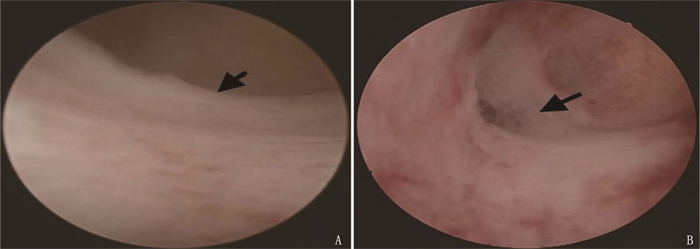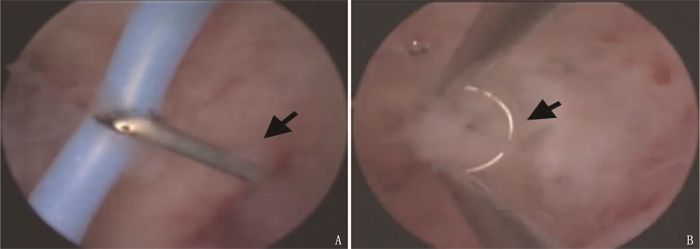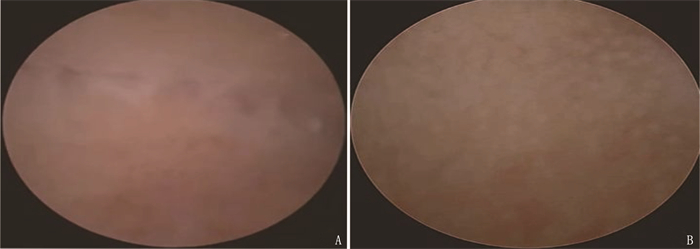Application value of modified hysteroscopic adhesiolysis in the treatment of thin endometrium
-
摘要:目的
探讨有效治疗薄型子宫内膜(TE)及复原子宫生殖功能的方法。
方法回顾性分析48例TE患者改良式宫腔粘连分离术前后经期天数、月经量的月经失血评估表(PBAC)评分及超声指标。
结果48例患者术后经期平均天数为(5.60±1.40) d, 长于术前的(4.30±1.20) d, 差异有统计学意义(P < 0.05); 术后月经量PBAC评分为(55.60±6.20)分, 高于术前的(21.40±5.60)分, 差异有统计学意义(P < 0.05); 手术前后双侧子宫动脉阻力指数(RI)均值和脉冲指数(PI)均值的差异无统计学意义(P>0.05); 术后子宫内膜厚度为(9.10±1.10) mm, 子宫内膜容积为(4.68±0.81) cm3, 大于术前的(4.30±1.20) mm和(3.21±0.31) cm3, 差异有统计学意义(P < 0.05); 术后子宫内膜的RI值为(0.51±0.13), PI值为(0.77±0.26), 低于术前的(0.59±0.07)和(0.91±0.18), 差异有统计学意义(P < 0.05)。48例患者妊娠率为60.4%。子宫内膜容积及子宫内膜厚度与妊娠呈正相关(P < 0.05), 子宫内膜RI值和PI值与妊娠呈负相关(P < 0.05)。
结论改电流切割为“冷针”物理机械分离瘢痕粘连组织, 可有效修复宫腔的瘢痕粘连,有利于术后子宫内膜血流重建,改善TE患者的宫腔容受性,复原子宫生殖功能。
Abstract:ObjectiveTo explore the effective therapeutic methods for thin endometrium (TE) and recovery of reproductive function of uterine.
MethodsMenstrual days, the Pictorial Blood Loss Assessment Chart (PBAC) score for menstrual volume, and ultrasound indicators before and after modified hysteroscopic adhesiolysis in 48 patients with TE were retrospectively analyzed.
ResultsThe average postoperative menstrual period of 48 patients was (5.60±1.40) days, which was significantly longer than (4.30±1.20) days before operation (P < 0.05); the postoperative PBAC score for menstrual volume was (55.60±6.20) points, which was significantly higher than (21.40±5.60) points before operation (P < 0.05); there were no significant differences in the mean resistance index (RI) and pulse index (PI) of bilateral uterine arteries before and after surgery (P>0.05); the postoperative endometrial thickness and the endometrial volume were (9.10±1.10) mm and (4.68±0.81) cm3, which were significantly higher than (4.30±1.20) mm and (3.21±0.31) cm3 before operation (P < 0.05); the postoperative RI value and PI value of the endometrium were (0.51±0.13) and (0.77±0.26), which were significantly lower than (0.59±0.07) and (0.91±0.18) before operation (P < 0.05). The pregnancy rate of 48 patients was 60.4%. The volume and thickness of the endometrium were positively significantly correlated with pregnancy (P < 0.05), while the RI and PI values of the endometrium were negatively significantly correlated with pregnancy (P < 0.05).
ConclusionChanging electric current cutting to "cold needle" physical and mechanical separation of scar adhesions can effectively repair scar adhesions in the uterine cavity, facilitate postoperative reconstruction of endometrial blood flow, improve uterine receptivity of TE patients, and restore uterine reproductive function.
-
新辅助放化疗(NCRT)可以实现肿瘤降期,降低肿瘤局部复发率,是局部晚期直肠癌(LCRC)的标准治疗策略[1]。研究[2]表明,约21%的LARC患者在NCRT后可达病理完全缓解(PCR)。这部分患者通常能够获得较长的生存期,并且其后续治疗采取观察等待策略,就可以获得与根治性手术相同的疗效[3]。此外,一项全程新辅助治疗与标准NCRT疗效对比荟萃分析[4]显示,全程新辅助治疗有助于提高LARC患者的PCR率,增加无病生存期和总生存期。因此对于NCRT反应较差的患者,选择强化的术前治疗策略有助于改善疗效。但是,不管是观察等待策略,还是全程新辅助治疗,均需敏感的生物标记物。在LARC患者行NCRT前预测其对治疗的敏感性,筛选出最可能获益的患者,这对患者后续行个体化治疗至关重要。
肿瘤微环境(TME)是肿瘤细胞赖以生存的微环境,其内免疫细胞可通过与肿瘤细胞以及其他细胞相互作用,影响结直肠肿瘤的进展和转移,并介导其对放化疗的反应[5-6]。近年来,许多研究[7-9]对TME中可能具有预测作用的免疫细胞进行了报道,如细胞毒性T细胞、程序性细胞死亡-配体1(PD-L1)、肿瘤相关巨噬细胞(TAMs)、调节性T细胞(Treg)和中性粒细胞与淋巴细胞比值(NLR)等,但目前关于这些指标在直肠癌患者NCRT疗效中的预测价值尚未达成共识。本文就以上免疫细胞在直肠癌NCRT中预测作用的研究进展予以综述,探讨这些免疫细胞作为预测直肠癌NCRT疗效生物标记物的可行性,为开展后续临床研究提供依据。
1. 细胞毒性T细胞与免疫检查点PD-L1
TME中免疫细胞在直肠癌治疗中的作用是一个有前景的研究领域。近年来,随着免疫治疗,特别是免疫检查点阻断疗法,一种通过抑制程序性细胞死亡受体-1(PD-1)/PD-L1轴来增强CD8+ T细胞介导的抗肿瘤免疫应答的治疗方法在临床上取得了巨大进展,人们越来越认识到肿瘤微环境中免疫特征如CD8+ T细胞和PD-L1可以预测患者临床治疗结果。
1.1 细胞毒性T细胞在直肠癌NCRT中的预测价值
细胞毒性T细胞,通常称为CD8+ T细胞,是适应性免疫反应的主要效应细胞,具有细胞溶解能力,可以特异性识别和杀伤肿瘤细胞,是抗肿瘤免疫的重要组成部分。CD8+ T细胞最初被发现与结直肠癌的预后密切相关,在GALON J等[10]研究中,通过测定415例结直肠肿瘤样本中心和侵袭边缘2个区域的总T淋巴细胞(CD3)、CD8+ T细胞及其相关的细胞毒性分子(GZMB)和记忆T细胞(CD45RO)的浸润密度,发现无复发患者适应性免疫细胞浸润密度高于复发患者,同时高密度的免疫浸润也与较好的无病生存期和总生存期相关。免疫评分是基于CD3+和CD8+ T细胞浸润水平建立的,是一种对肿瘤预后进行判断的检测方法,其原理是测定肿瘤核心和侵袭边缘CD8+和CD3+ T细胞的浸润密度,在2个区域2种细胞浸润高为高评分,反之则为低评分[11]。MLECNIK B等[12]首先在结直肠癌中证实了免疫评分对肿瘤预后的预测价值要优于TNM分期。随后ANITEI M G等[13]在研究中进一步证实了该发现,并在55例进行NCRT的直肠癌患者治疗前活检中发现, CD8+和CD3+ T细胞高浸润与NCRT后肿瘤分期降低有关,说明治疗前取活检对免疫细胞浸润密度进行测定有助于预测患者对NCRT反应性。这种利用直肠癌患者NCRT前活检标本进行免疫评分的方式,即为活检适应性免疫评分,是对结肠癌手术标本进行标准化免疫评分的改进。SISSY C E等[14]为进一步评估活检适应性免疫评分对LARC患者NCRT敏感性的预测价值。通过对322例LARC患者治疗前活检标本进行CD3+和CD8+ T细胞免疫染色,并确定其活检适应性免疫评分,发现评分高的患者局部复发率低,对新辅助治疗更为敏感,并且那些评分高的患者,在观察等待策略中获益最大。该研究证实了活检适应性免疫评分对LARC患者NCRT疗效的预测价值,有助于为直肠癌患者提供个体化的治疗选择。
目前,基于综合测定CD3+和CD8+ T细胞浸润密度的免疫评分的预测价值已在多项研究中得到验证。此外, CD8+ T细胞的独立预测价值也同样得到肯定。例如, MATSUTANI S等[15]研究表明, LARC患者NCRT后手术切除标本中CD8+ T细胞密度较治疗前活检标本显著升高,且治疗前后活检样本中CD8+ T细胞的低密度与对NCRT反应较差有关。另外,在一项系统综述和荟萃分析中[16]发现,相比于治疗前CD8+ T细胞密度低的患者, CD8+ T密度高的患者获得PCR的可能性更大。结合以上研究可以看出,CD8+ T细胞浸润密度与NCRT治疗疗效呈正相关。其原因可能为细胞毒性药物和辐射可通过杀伤肿瘤细胞,促使肿瘤细胞释放新抗原,在肿瘤内原有CD8+ T细胞浸润密度的基础上,进一步增加CD8+ T细胞的募集,提高了局部抗肿瘤免疫反应。两者协同作用得以产生更好的治疗效果。因此,CD8+ T细胞作为预测LARC患者NCRT疗效的生物标记物极具前景。但目前不管是活检适应性免疫评分,还是通过测定患者治疗前活检中CD8+ T细胞浸润水平以预测患者治疗反应,均缺乏大样本量的临床研究,实现临床应用还面临许多阻碍。未来还需在更大的患者队列中进行回顾性和前瞻性验证,以使其早日应用于直肠癌。
1.2 PD-L1在直肠癌NCRT中的预测价值
PD-L1全称为程序性细胞死亡-配体1,可以在T细胞、B细胞、巨噬细胞和树突状细胞中表达,并在干扰素的作用下上调。通过与PD-1结合,抑制T细胞的增殖和细胞因子的产生,在肿瘤免疫耐受和免疫逃逸中起着关键作用[17]。目前,靶向PD-1/PD-L1轴的免疫检查点阻断疗法,已在多种实体肿瘤中得到应用,并且取得了临床获益[18]。但在结直肠癌中,仅有少数患者可以从免疫治疗中获益[19]。
为探索PD-L1表达水平与直肠癌预后以及NCRT反应之间的相关性,近年来开展了一系列的研究。SAIGUSA S等[20]研究发现, PD-L1高表达患者较PD-L1低表达患者更容易发生血管侵犯和肿瘤复发,并且PD-L1的高表达还与较差的无复发生存率和总生存率显著相关。此外,该研究还发现PD-L1高表达患者中CD8+ T细胞的浸润数量显著低于PD-L1低表达患者,证明了PD-L1表达与CD8+ T细胞的浸润密度呈负相关。而CD8+ T细胞浸润通常与较好的治疗反应有关,这提示PD-L1的表达水平可能与NCRT疗效存在一定的相关性,控制PD-L1的表达可能有助于提高直肠癌患者NCRT疗效。尽管有许多发现,但这项研究的局限性在于存在两种术前放化疗方案,且NCRT与手术间隔时间也不同。在纳入的90例直肠癌患者中, 43例接受了短疗程放化疗,而其余47例行长程放化疗,并分别于治疗后2~3周和4~6周后行根治性手术。人体内单核细胞通常包括经典单核细胞、中间单核细胞和非经典单核细胞3类,其中非经典单核细胞因其主要在血管中迁移,寻找有害微粒或受损内皮细胞,并对其进行清除来维持血管稳态,又被称为巡逻单核细胞[21]。TOJO M等[22]首次报道了循环单核细胞中PD-L1表达与肿瘤对NCRT反应之间的相关性,证明了PD-L1在巡逻单核细胞上的表达与LARC患者对NCRT的反应呈负相关,是NCRT疗效的独立预测因素。之后, TAKAHASHI H等[23]通过研究109例LARC患者PD-L1和PD-1, 以及核β-catenin几种免疫学相关标记物和NCRT抵抗之间的关系,发现基质内高水平的PD-L1阳性免疫细胞浸润和肿瘤内核β-catenin的高表达与NCRT治疗反应较差相关,可作为预测LARC患者对NCRT治疗抵抗的指标。以上研究均表明, PD-L1的低表达与较好的治疗反应相关。与上述研究结果相反的是, ZHANG S Y等[24]研究显示,新辅助治疗前后PD-L1高表达的患者可能获得良好的治疗反应。目前PD-L1表达的高低与NCRT疗效的相关性仍存在争议。评价病理反应的标准不同和评估PD-L1表达高低的临界值的非标准化是导致研究结果产生差异的重要原因。因此,未来为进一步探索PD-L1和NCRT反应之间的潜在作用机制,明确其预测价值,不仅需要继续开展更多的临床试验,还需要在今后的研究中尽量遵循相同的病理反应评价标准,并对LARC患者PD-L1检验临界值进行确定。
2. TAMs在直肠癌NCRT中的预测价值
TAMs是TME的重要组成部分,起源于循环系统中的单核细胞或组织内的巨噬细胞,并在TME的刺激下分化为TAMs。作为其来源的巨噬细胞在生理微环境的刺激下通常可以分化成为2种表型。一种为经典激活巨噬细胞,即M1型巨噬细胞。另一种是替代激活巨噬细胞,即M2型巨噬细胞。在结直肠肿瘤细胞的生长过程中分别具有促肿瘤和抗肿瘤的作用[25]。研究[26]表明, TAMs通常具有M2型巨噬细胞的表型和功能,可通过分泌多种细胞因子或借助外泌体促进肿瘤细胞增殖、刺激肿瘤相关血管生成、抑制抗肿瘤免疫反应,促进肿瘤的进展和转移,并且还与结直肠肿瘤治疗耐药相关。一项体外实验证实, M2型TAMs可通过释放CCL22, 激活PI3K/AKT通路以抵消5-氟尿嘧啶的抗肿瘤作用,从而导致化疗耐药[27]。为探索TAMs细胞在LARC患者NCRT疗效中的预测价值, LIU X等[28]通过使用免疫组化对191例LARC患者NCRT前后收集的肿瘤样本进行分析,发现TME中较高密度的TAMs浸润与LARC患者较差的预后密切相关。随后基于NCRT前活检样本中巨噬细胞相关生物标志物CD163、CD68、MCSF和CCL2表达水平建立了用于预测LARC患者预后和NCRT反应的风险评分模型,发现巨噬细胞相关生物标记物的高表达与非PCR密切相关,高评分患者通常对NCRT反应较差,在NCRT之后可以考虑更强化的辅助治疗以提高疗效。之后, YANG Y Q等[9]为探索免疫细胞浸润密度与治疗反应之间的相关性,纳入了76例LARC患者。检测患者NCRT前活检样本中免疫细胞浸润情况,之后对患者免疫特征与临床治疗反应行单因素和多因素分析,发现高水平的TAMs与非PCR密切相关。可以看出,肿瘤内TAMs的高密度常与NCRT疗效较差有关,有成为预测NCRT疗效的生物标记物的潜力。但目前有关TAMs预测LARC患者NCRT疗效的研究较少,且多为回顾性研究。因此,为使TAMs未来有助于患者临床治疗方案的选择,需要进行大规模的前瞻性临床试验来证实之前的研究结果。
3. Treg在直肠癌NCRT中的预测价值
Treg是一类以CD25和叉头状/翼状螺旋转录因子3 (Foxp3) 表达为主的免疫抑制细胞,可通过抑制抗原提呈细胞的成熟、竞争性耗竭IL-2、分泌免疫抑制性细胞因子、表达颗粒酶和穿孔素杀死效应T细胞等方式发挥其免疫抑制功能[29]。Treg在多种肿瘤中已被证明与预后不良相关[30]。但在结直肠癌中,调节性T细胞对预后的影响是有争议的。例如,JI D B等[31]研究证实, Treg的浸润密度与LARC患者预后呈负相关。而在其他研究中, Treg则被证明密度的增加与结直肠癌预后良好相关[32-33]。目前,有关Treg浸润与NCRT敏感性的部分研究结果存在矛盾。SHINTO E等[34]通过对93例直肠癌患者NCRT前后的活检标本进行CD8和Foxp3免疫染色,发现在治疗前活检中, CD8+ /Foxp+高比值与肿瘤消退相关。而MCCOY M J等[35]研究则证明NCRT前TME中Foxp3+ Tregs浸润密度与LARC患者肿瘤消退无关。2项研究结果之间缺乏一致性,可能是因为SHINTO E等研究中患者接受的NCRT均为短疗程放化疗(20 Gy/5f, 4 Gy/f; 尿嘧啶7 d), 而MCCOY M J等研究中患者接受的术前治疗为长程放化疗(50.4 Gy/28f, 1.8 Gy/f; 5-氟尿嘧啶),相较于长程放化疗,短程放化疗后PCR率较低[36], 因此短程放化疗与长疗程放化疗研究结果可能存在差异。此外, MCCOY M J等[37]进行的另一项研究通过评估128例直肠癌患者NCRT后手术切除样本中T细胞亚群与临床结果的相关性,发现治疗后Foxp3+ Treg的低密度与更高的PCR率有关。此后, SEKIZAWA K等[38]通过对65例接受新辅助化疗后行根治性切除的直肠癌患者手术切除标本行免疫组化分析,同样发现新辅助化疗后低密度的Foxp3+ Treg浸润与LARC的肿瘤退缩相关。基于以上研究结果,目前治疗前Foxp3+ Treg浸润是否与LARC对NCRT敏感性有关仍有争议,未来仍需继续开展大规模临床研究证实Foxp3+ Treg的预测作用。而治疗后低密度的Foxp3+ Treg浸润被证明与肿瘤消退有关,说明Foxp3+ Treg可能通过其免疫抑制功能抑制患者对NCRT的反应。一项临床前小鼠实验[31]表明,放疗联合耗竭的Treg的治疗策略可增强直肠癌治疗疗效,并可产生远隔效应。因此,在LARC患者NCRT治疗过程中,通过减少Treg肿瘤内浸润密度,以改善治疗反应,有望成为直肠癌的一个治疗靶点。
4. NLR在直肠癌NCRT中的预测价值
NLR是一种有效的系统性炎症标志物,可参与肿瘤的进展。多项研究[39-40]表明, NLR的高比值通常与结直肠癌患者的预后不良有关。此外, NLR还被证明可作为预测直肠癌放化疗反应的生物标志物。在一项评估NLR预测价值的研究中, KIM I Y等[41]通过分析102例直肠癌患者NLR值和病理反应的相关性,发现放化疗前NLR升高(≥3)可作为NCRT反应性差的预测指标。因为当NLR升高时,中性粒细胞的促肿瘤作用占优势或是淋巴细胞的抗肿瘤免疫反应降低,可能导致患者对NCRT的反应性较差。在2019年发表的2项血液学生物标记物对LARC患者NCRT反应预测价值的研究中同样表明,治疗前较高的NLR与LARC患者NCRT后较差的病理反应相关[42-43]。但2项研究NLR临界值差异较大,分别为1.78和4.06。还有研究将4.50作为NLR的临界值来预测LARC患者对NCRT的反应性。ANDRAS D等[44]研究发现当NLR<4.5时,患者表现为治疗后部分或完全病理缓解。而NLR>4.5, 则提示治疗反应差或无反应,其预测患者对放化疗反应性差的准确性为0.85, 敏感性和特异性均为83.3%。许宁等[45]通过分析148例LARC患者治疗前NLR和治疗反应的相关性,发现较高的NLR(>3.88)与较差的治疗反应相关。以上研究可以看出,虽然NLR水平与患者对NCRT反应性具有一定的相关性,但目前NLR尚无统一的临界值来预测患者对NCRT反应。未来需要对不同的临界值进行验证,选取最具敏感性和特异性的NLR值作为最佳临界值,从而更精准地预测放化疗疗效。
令人遗憾的是,虽然目前已有相当一部分研究证明了NLR与LARC患者NCRT疗效有关,但仍有部分研究结果与之相反。例如, LINO-SILVA L S等[46]研究发现, NLR值与LARC患者对NCRT的反应性无关。此外,一项大型回顾性研究[47]结果显示, NLR并非PCR的独立预测因素,同样证明了NLR与LARC患者的治疗反应无关。因此,NLR的预测价值尚未明确,但因NLR具有获取简单且经济有效的特点,将其与影像、肿瘤标记物等预测指标相结合预测患者NCRT疗效,可能有助于提高当前临床评估方法的准确性,也可以使患者获益。
5. 小结
预测LARC患者对NCRT的反应性至关重要,其反应性的高低对后续治疗具有指导意义。对于反应良好者,可以选择观察等待策略,避免手术带来的副作用,并提高生活质量; 对于反应较差者,可选择全程新辅助放化疗,通过强化新辅助治疗以优化患者治疗结果;或尽快尝试其他治疗方法,以避免延误治疗时机。目前,利用TME中免疫细胞来预测LARC患者NCRT疗效尚未应用于临床。因为目前研究多为回顾性研究,且样本量较小。在各项研究中不同患者之间放疗剂量、新辅助放化疗与手术间隔时间、化疗药物使用等存在差异,这些临床差异可能会导致患者对NCRT的反应性不同,从而导致研究结果的可信度不高。此外,一些免疫细胞在LARC患者NCRT疗效中的预测价值存在争议。因此,仍需继续深入探索研究,在更大规模的队列研究和前瞻性临床试验中验证这些免疫细胞的预测价值,尝试采取联合多种生物标记物的方式提高预测的准确性,从而使得更多的患者受益。
-
表 1 手术前后超声观测指标比较(x±s)
指标 术前(n=48) 术后(n=48) 子宫内膜厚度/mm 4.30±1.20 9.10±1.10** 子宫内膜容积/cm3 3.21±0.31 4.68±0.81** 双侧子宫动脉RI均值 0.67±0.14 0.64±0.13 双侧子宫动脉PI均值 1.38±0.24 1.35±0.26 子宫内膜RI值 0.59±0.07 0.51±0.13* 子宫内膜PI值 0.91±0.18 0.77±0.26** RI: 阻力指数; PI: 脉冲指数。
与术前比较, * P < 0.05, * * P < 0.01。 -
[1] LIU K E, HARTMAN M, HARTMAN A. Management of thin endometrium in assisted reproduction: a clinical practice guideline from the Canadian Fertility and Andrology Society[J]. Reprod Biomed Online, 2019, 39(1): 49-62. doi: 10.1016/j.rbmo.2019.02.013
[2] 王子君, 杨慕坤, 毛乐乐, 等. 自体富血小板纤维蛋白治疗宫腔粘连性不孕症的疗效分析[J]. 实用临床医药杂志, 2021, 25(7): 6-10. doi: 10.7619/jcmp.20210336 [3] RANISAVLJEVIC N, RAAD J, ANAHORY T, et al. Embryo transfer strategy and therapeutic options in infertile patients with thin endometrium: a systematic review[J]. J Assist Reprod Genet, 2019, 36(11): 2217-2231. doi: 10.1007/s10815-019-01576-w
[4] 张家诚, 辛喜艳, 叶阳, 等. 子宫内膜容受性低下动物模型建立方法概述[J]. 生殖医学杂志, 2023, 32(5): 785-792. https://www.cnki.com.cn/Article/CJFDTOTAL-SZYX202305024.htm [5] 袁纯, 钱易, 高彦, 等. 宫腔粘连分离术后患者内膜因素对IVF/ICSI-ET助孕结局的影响分析[J]. 生殖医学杂志, 2021, 30(7): 885-889. https://www.cnki.com.cn/Article/CJFDTOTAL-SZYX202107010.htm [6] 赵静, 黄国宁, 孙海翔, 等. 辅助生殖技术中异常子宫内膜诊疗的中国专家共识[J]. 生殖医学杂志, 2018, 27(11): 1057-1064. https://www.cnki.com.cn/Article/CJFDTOTAL-SZYX201811003.htm [7] 李辉杰, 魏红英, 朱新全. 改良式宫腔镜治疗子宫瘢痕憩室的疗效及生殖预后[J]. 福建医科大学学报, 2022, 56(1): 66-70. https://www.cnki.com.cn/Article/CJFDTOTAL-FJYD202201013.htm [8] MAGNAY J L, O'BRIEN S, GERLINGER C, et al. A systematic review of methods to measure menstrual blood loss[J]. BMC Womens Health, 2018, 18(1): 142. doi: 10.1186/s12905-018-0627-8
[9] 赵一, 冯力民, 张君妍. 宫内病变与妊娠的关系[J]. 实用妇产科杂志, 2017, 33(4): 248-251. https://www.cnki.com.cn/Article/CJFDTOTAL-SFCZ201704005.htm [10] CASPER R F. It's time to pay attention to the endometrium[J]. Fertil Steril, 2011, 96(3): 519-521. doi: 10.1016/j.fertnstert.2011.07.1096
[11] 杨冬梅, 吴芳, 孙晓吉, 等. 调冲益气补肾法联合任脉灸治疗薄型子宫内膜不孕症伴月经过少的临床观察[J]. 中国临床医生杂志, 2021, 49(3): 358-360. https://www.cnki.com.cn/Article/CJFDTOTAL-ZLYS202103033.htm [12] 黄小杏, 刘佳欣, 梁秀冰, 等. 雄性激素受体在Ⅰ型和Ⅱ型子宫内膜癌中的差异及其与预后的相关性研究[J]. 空军军医大学学报, 2022, 43(3): 198-202. https://www.cnki.com.cn/Article/CJFDTOTAL-DSJY202203014.htm [13] YANG W, ZHANG T, LI Z, et al. Combined analysis of endometrial thickness and pattern in predicting clinical outcomes of frozen embryo transfer cycles with morphological good-quality blastocyst: a retrospective cohort study[J]. Medicine, 2018, 97(2): e9577. doi: 10.1097/MD.0000000000009577
[14] MIWA I, TAMURA H, TAKASAKI A, et al. Pathophysiologic features of "thin" endometrium[J]. Fertil Steril, 2009, 91(4): 998-1004. doi: 10.1016/j.fertnstert.2008.01.029
[15] LIN Y F, DONG S N, YE X H, et al. Synergistic regenerative therapy of thin endometrium by human placenta-derived mesenchymal stem cells encapsulated within hyaluronic acid hydrogels[J]. Stem Cell Res Ther, 2022, 13(1): 66. doi: 10.1186/s13287-022-02717-2
[16] XIA L J, MENG Q Y, XI J, et al. The synergistic effect of electroacupuncture and bone mesenchymal stem cell transplantation on repairing thin endometrial injury in rats[J]. Stem Cell Res Ther, 2019, 10(1): 244. doi: 10.1186/s13287-019-1326-6
[17] 郑嘉华, 赵双丹, 亓文博, 等. 两种宫腔粘连大鼠模型稳定性的比较[J]. 中华生殖与避孕杂志, 2021, 41(12): 1117-1123. [18] JIN X, YE J L, ZHANG L, et al. Efficacy of hysteroscopic cold knife separation on intrauterine adhesions[J]. Am J Transl Res, 2021, 13(7): 8351-8357.
[19] LI C Q, CONG L, WANG W Y. Two cases of larger cornual residual villi, treated by the hysteroscopic cold knife[J]. J Obstet Gynaecol Res, 2020, 46(11): 2430-2434. doi: 10.1111/jog.14416
[20] NG E H, YEUNG W S, HO P C. Endometrial and subendometrial vascularity are significantly lower in patients with endometrial volume 2.5 ml or less[J]. Reprod Biomed Online, 2009, 18(2): 262-268. doi: 10.1016/S1472-6483(10)60264-7
-
期刊类型引用(0)
其他类型引用(2)





 下载:
下载:


 苏公网安备 32100302010246号
苏公网安备 32100302010246号